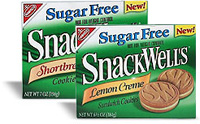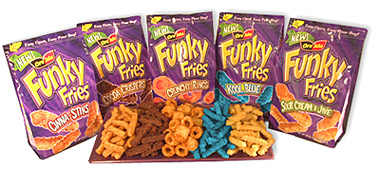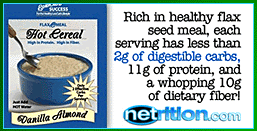
According to The Food Marketing Institute (FMI, the food retail-wholesale trade
association) polls and studies confirm that food shoppers (including restaurant
patrons) continue to care less and less about health and nutrition, and just want
good taste. In these studies, foods with the highest sugar content (including those
added to soups, sauces, breads and side dishes) were those consumers referred
to as "having more taste".
If you see a marketing statement that declares, "now with more flavor!" Or "New
added taste!", you can bet they've upped the sugars and carbs again. Why not? They're
feeding an addiction.
One of the most recent announcements of what I consider an "insane product" comes
from HJ Heinz�. Beginning in May of this year, they will ship a
new line of Ore-Ida frozen potato products called "Funky Fries" featuring
five new shapes, colors and flavors.
|
The new products include french fries flavored with sour cream and chives (called
"Sour Cream and Jive",)
cinnamon-and-sugar "Cinna-Stiks", and "Crunchy Rings" — basically
Tater-Tots with a hole in the middle. (All are processed with trans fats and added
sugars.)
But here are the two real kickers: There's "Kool Blue," a sky blue, seasoned
(sugar added) french fry; and brown, chocolatey
"Cocoa Crispers," designed "for kids with a sweet tooth."
And parents are supposed to feel good about filling their children with
these? Well, obviously marketing studies show plenty of parents will do just
that. Kids with a sweet tooth, huh? Well, I do agree they're "funky"...
According to their own press releases, they asked the kids "what would make them
want to eat more french fries?" Of course the answer was to make them sweet.
We hook our children early in life, and they crave all they can get.
While in a business' waiting room the other day, I picked up a Food Science
magazine and flipped through the pages. I found this:
 "Many product designers find that using sweeteners can provide a wide range of
benefits in savory foods. The flavor - as well as the appearance, texture and
even the shelf life - may benefit from a spoonful of sugar.
"Many product designers find that using sweeteners can provide a wide range of
benefits in savory foods. The flavor - as well as the appearance, texture and
even the shelf life - may benefit from a spoonful of sugar.
The use of sweeteners in savory products appears to be on the rise, largely
because of the changing tastes of the American consumer. In some products, a
gradual shift has occurred; as manufacturers have added more sugar to certain
products, people have begun to prefer them at higher sweetness levels.
"Look at hot dogs, for example," points out Paul Maki, principal scientist,
Griffith Laboratories, Alsip, IL. "If you go back 30 or 40 years you would
never see sugars or any sweeteners in them. Now you have fairly high levels
of corn syrup solids, dextrose or sorbitol to provide a certain level of
sweetness which enhances the consumer acceptability of the product."
I think you can see why America's driving need for that acceptable drug, sugar,
continues to increase year to year... along with our waistlines, and the
incidence of heart disease, cancer, and diabetes.
It's no surprise then that of the 100 to 160 pounds (depending on data source) of
sugar per person per year consumed in North America, approximately 70% of
that comes from sugar supplied as an additive to prepared foods.
And for those that are interested in "healthy" foods, marketers know
that what is healthy is unimportant. What matters is what is perceived
as being healthy.
To that end, we have "nutrition bars" and granola bars that are nearly pure
sugar, chemicals, and trans fats. We have so-called-healthy yogurts maxed out
with sugar. We have soy milks marketed in health food stores with chocolate and strawberry
flavoring added — along with between 22 and 44 grams of sugar per serving!
 We have new "women's cereals" that boast "low fat" and "calcium enriched" from
General Mills (Harmony Women's Cereal) and from Kellogg's (Smart Start).
We have new "women's cereals" that boast "low fat" and "calcium enriched" from
General Mills (Harmony Women's Cereal) and from Kellogg's (Smart Start).
General Mills' marketing declares, "women don't have the time or patience to remember
all of the vitamins and minerals they need each day to stay healthy. Harmony
makes it easy. Simply pour yourself a bowl of cereal and you'll get many of the
important nutrients you need." They never mention a few things you might want to
know:
- A single serving offers up 13 grams of pure sugar.
- The nutrition facts for Harmony list a serving, oddly, as 1 1/4 cups
(or 55 grams - mostly pure carbohydrate). Now most cereals are listed as
either a 1-cup serving (44 grams) or a 28-gram serving ( 5/8 cup). A serving
size of 1 1/4 cups makes it a just-plain bigger serving any way you look at it
than is represented on other cereals' nutrition labels, giving an inflated
picture of the amounts of nutrients it contains. In fact, if you compare it
to Total, the nutrients are FAR less.
It's all about marketing.
So here's this box, sitting on the shelf, calling to women ... appealing to
their desire for a healthy lifestyle. The box is gently swathed in strokes
of baby blue and soft yellow. Near the top, the silhouette of a woman's body
raises her arms heavenward, in victory. It looks like a dream. Its name is
Harmony.
On the back of the box, a middle-aged woman wearing a cable-knit sweater
stands on a seashore, and again, she is raising her arms above her head.
To some (like me) she is indicating that a field goal has been scored. To
others, she is celebrating her empowerment.
On the back, in elegant italics, is the cereal's philosophy: Meeting the
nutritional needs of women is what Harmony cereal is all about.
Did I mention it's all about marketing?
It's not all bad news...
Reports show that sales of fat-free foods have plummeted since their
heyday in the mid-1990s, and many low-fat foods are suffering, too. Sales
of fat-free ice cream dropped 20 percent in 2001 and 25 percent the year
before, according to ACNielsen.
The picture is just as bleak for Nabisco's SnackWell's cookies. Sales
have fallen from a peak of $349 million in 1995 to $126 million in 2000,
according to Information Resources.
As some no-fat products disappear from supermarket shelves, packages
taking their place declare: "Sugarfree" and "no-sugar-added".
 Sugarfree SnackWell's cookies debuted last fall. Yes, they are in addition to
their low-fat and fat free line, and no you shouldn't eat them — they're still
high carb and made with white flour and trans fats. But it's a sign of
that old "paradigm shift" I have spoken of before... An irony of these products
is that their labels proclaim that they are "not for
weight control" because they are not low in calories or fat. But of course sugar
free products will take weight off far faster than fat free products. It gives
me a chuckle every time...
Sugarfree SnackWell's cookies debuted last fall. Yes, they are in addition to
their low-fat and fat free line, and no you shouldn't eat them — they're still
high carb and made with white flour and trans fats. But it's a sign of
that old "paradigm shift" I have spoken of before... An irony of these products
is that their labels proclaim that they are "not for
weight control" because they are not low in calories or fat. But of course sugar
free products will take weight off far faster than fat free products. It gives
me a chuckle every time...

Breyers introduced indulgence flavors like chocolate caramel and butter pecan to its
no-sugar-added line last year and plans French vanilla for this
year. Such ice creams are "popular because of the rising number
of diabetics," Breyers spokesmen said, "and because so many consumers are
on low-carb diets and trying to cut sugar consumption."
Breyers dropped four of
its five fat-free ice creams this month, (although it's holding on to its
reduced-fat flavors.) Well, at least somebody's noticing.
Just My Thoughts,

|







 "Many product designers find that using sweeteners can provide a wide range of
benefits in savory foods. The flavor - as well as the appearance, texture and
even the shelf life - may benefit from a spoonful of sugar.
"Many product designers find that using sweeteners can provide a wide range of
benefits in savory foods. The flavor - as well as the appearance, texture and
even the shelf life - may benefit from a spoonful of sugar.
 We have new "women's cereals" that boast "low fat" and "calcium enriched" from
General Mills (Harmony Women's Cereal) and from Kellogg's (Smart Start).
We have new "women's cereals" that boast "low fat" and "calcium enriched" from
General Mills (Harmony Women's Cereal) and from Kellogg's (Smart Start).
 Sugarfree SnackWell's cookies debuted last fall. Yes, they are in addition to
their low-fat and fat free line, and no you shouldn't eat them — they're still
high carb and made with white flour and trans fats. But it's a sign of
that old "paradigm shift" I have spoken of before... An irony of these products
is that their labels proclaim that they are "not for
weight control" because they are not low in calories or fat. But of course sugar
free products will take weight off far faster than fat free products. It gives
me a chuckle every time...
Sugarfree SnackWell's cookies debuted last fall. Yes, they are in addition to
their low-fat and fat free line, and no you shouldn't eat them — they're still
high carb and made with white flour and trans fats. But it's a sign of
that old "paradigm shift" I have spoken of before... An irony of these products
is that their labels proclaim that they are "not for
weight control" because they are not low in calories or fat. But of course sugar
free products will take weight off far faster than fat free products. It gives
me a chuckle every time...


